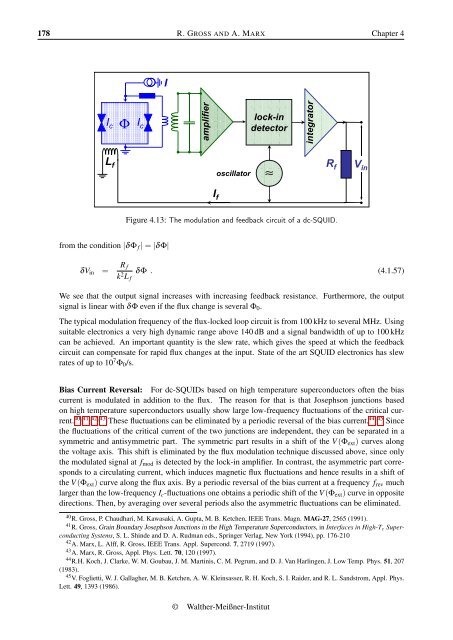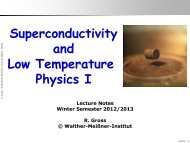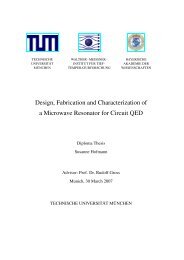Applied Superconductivity - Walther Meißner Institut - Bayerische ...
Applied Superconductivity - Walther Meißner Institut - Bayerische ...
Applied Superconductivity - Walther Meißner Institut - Bayerische ...
- No tags were found...
You also want an ePaper? Increase the reach of your titles
YUMPU automatically turns print PDFs into web optimized ePapers that Google loves.
178 R. GROSS AND A. MARX Chapter 4II cΦI camplifierlock-indetectorintegratorL foscillator≈R fV inI fFigure 4.13: The modulation and feedback circuit of a dc-SQUID.from the condition |δΦ f | = |δΦ|δV in = R fk 2 L fδΦ . (4.1.57)We see that the output signal increases with increasing feedback resistance. Furthermore, the outputsignal is linear with δΦ even if the flux change is several Φ 0 .The typical modulation frequency of the flux-locked loop circuit is from 100 kHz to several MHz. Usingsuitable electronics a very high dynamic range above 140 dB and a signal bandwidth of up to 100 kHzcan be achieved. An important quantity is the slew rate, which gives the speed at which the feedbackcircuit can compensate for rapid flux changes at the input. State of the art SQUID electronics has slewrates of up to 10 7 Φ 0 /s.Bias Current Reversal: For dc-SQUIDs based on high temperature superconductors often the biascurrent is modulated in addition to the flux. The reason for that is that Josephson junctions basedon high temperature superconductors usually show large low-frequency fluctuations of the critical current.40,41,42,43 These fluctuations can be eliminated by a periodic reversal of the bias current. 44,45 Sincethe fluctuations of the critical current of the two junctions are independent, they can be separated in asymmetric and antisymmetric part. The symmetric part results in a shift of the V (Φ ext ) curves alongthe voltage axis. This shift is eliminated by the flux modulation technique discussed above, since onlythe modulated signal at f mod is detected by the lock-in amplifier. In contrast, the asymmetric part correspondsto a circulating current, which induces magnetic flux fluctuations and hence results in a shift ofthe V (Φ ext ) curve along the flux axis. By a periodic reversal of the bias current at a frequency f rev muchlarger than the low-frequency I c -fluctuations one obtains a periodic shift of the V (Φ ext ) curve in oppositedirections. Then, by averaging over several periods also the asymmetric fluctuations can be eliminated.40 R. Gross, P. Chaudhari, M. Kawasaki, A. Gupta, M. B. Ketchen, IEEE Trans. Magn. MAG-27, 2565 (1991).41 R. Gross, Grain Boundary Josephson Junctions in the High Temperature Superconductors, in Interfaces in High-T c SuperconductingSystems, S. L. Shinde and D. A. Rudman eds., Springer Verlag, New York (1994), pp. 176-21042 A. Marx, L. Alff, R. Gross, IEEE Trans. Appl. Supercond. 7, 2719 (1997).43 A. Marx, R. Gross, Appl. Phys. Lett. 70, 120 (1997).44 R.H. Koch, J. Clarke, W. M. Goubau, J. M. Martinis, C. M. Pegrum, and D. J. Van Harlingen, J. Low Temp. Phys. 51, 207(1983).45 V. Foglietti, W. J. Gallagher, M. B. Ketchen, A. W. Kleinsasser, R. H. Koch, S. I. Raider, and R. L. Sandstrom, Appl. Phys.Lett. 49, 1393 (1986).© <strong>Walther</strong>-Meißner-<strong>Institut</strong>
















